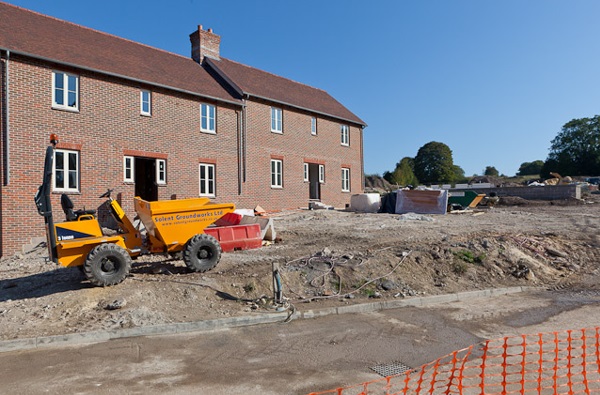How does the state of the economy influence the construction industry?
Contents |
[edit] Introduction
The housing market and the construction industry have long been used as indicators of the strength or weakness of the domestic economy. When the economy is sluggish, the housing market takes a down turn. If construction companies are not building or building contracts hard to come by, it is usually indicative of a slow economy. But why?
[edit] The ups and downs of the economy
The economy is about money, but it is also about confidence too. When the economy is sluggish, people don’t have the confidence to borrow money to buy property and neither do big construction companies have the investment to build large scale projects.
Construction is a cyclical industry meaning that when the economy is buoyant, it is an industry that gains strength.
But when the economy downturns, larger construction companies can suffer. For smaller construction businesses, this can be good news; customers may not be willing to invest in larger scale projects but they may want smaller projects completing.
[edit] A strong economy
A strong economy, or one considered to be on an upswing, has the effect of raising incomes and encouraging entrepreneurship. Rising incomes reinforces demand. With the confidence the spend the extra money in their pocket, people will often look to invest in property, ideal for planning for the future.
A construction company will take advantage of this financial confidence, creating bespoke construction solutions for private and commercial customers.
[edit] A weak economy
Lower incomes, or the fear of financial instability, knocks confidence and this means that people are far more conservative in not only how much they spend but what on. Taking on larger mortgages is not the first point of action for many people when the economy is sluggish.
For many businesses, especially construction companies, this is not good news. They don’t want to build large scale projects only to have them stand empty, with no demand. In some cases, it doesn’t necessarily mean that there is no demand but banks are not lending as freely as they once did.
This affects not just domestic projects but commercial construction projects too. However, there are counter considerations to this.
[edit] Solutions when the economy is sluggish
There are companies who look at the economy in a different way. When it is sluggish or in a down turn, it doesn’t mean that all building stops. Builders with a keen eye for offering different design and construction will service contracts, no matter what the state of the economy is.
For example, when budgets are tight but building solutions need to be found, customers can be more willing to try ‘something different’. And should a more cost-effective build solution come along, they will jump at the chance.
Consider modular building, for example. A modern, higher-quality version of pre-fabricated buildings. Unfortunately, for some time, these types of buildings have had a poor reputation. Used as temporary housing after the Second World War, they were used well-beyond their prime. They were poorly constructed, damp and cold.
But not so with the modern version of pre-fab buildings. Modular buildings are versatile. They can take on the façade of being old and traditional from the outside or they can be cutting edge, a beautiful piece of architecture that is practical, warm and eco-friendly.
But there is another advantage with modular buildings: they are cost-effective. Consuming fewer materials and energy to build, they are not only more environmentally friendly than traditional building processes, they also take less time to build. And as anyone in the construction industry knows, time is money.
Still using skilled tradespeople to design and build the modular units, the economy is not such a big concern for modular build companies. Agile and lean, they are a flourishing business with a product that is cost-effective, whether the economy is flat or riding the crest of a wave.
[edit] Demand and supply
There is constant media speculation relating to the lack of housing and how we need to be building so many thousands of new homes. And yet, this doesn’t seem to happen, a combination of finding suitable land, passing planning permission and finding the money to invest in such large-scale projects. And with Brexit on the horizon, it could become an even more complex situation.
Isn’t it time that demand and supply within construction are met without the economy dictating what and how properties are built?
[edit] Find out more
[edit] Related articles on Designing Buildings Wiki
Featured articles and news
The UK's Modern Industrial Strategy: A 10 year plan
Previous consultation criticism, current key elements and general support with some persisting reservations.
Building Safety Regulator reforms
New roles, new staff and a new fast track service pave the way for a single construction regulator.
Architectural Technologist CPDs and Communications
CIAT CPD… and how you can do it!
Cooling centres and cool spaces
Managing extreme heat in cities by directing the public to places for heat stress relief and water sources.
Winter gardens: A brief history and warm variations
Extending the season with glass in different forms and terms.
Restoring Great Yarmouth's Winter Gardens
Transforming one of the least sustainable constructions imaginable.
Construction Skills Mission Board launch sector drive
Newly formed government and industry collaboration set strategy for recruiting an additional 100,000 construction workers a year.
New Architects Code comes into effect in September 2025
ARB Architects Code of Conduct and Practice available with ongoing consultation regarding guidance.
Welsh Skills Body (Medr) launches ambitious plan
The new skills body brings together funding and regulation of tertiary education and research for the devolved nation.
Paul Gandy FCIOB announced as next CIOB President
Former Tilbury Douglas CEO takes helm.
UK Infrastructure: A 10 Year Strategy. In brief with reactions
With the National Infrastructure and Service Transformation Authority (NISTA).
Ebenezer Howard: inventor of the garden city. Book review.
The Grenfell Tower fire, eight years on
A time to pause and reflect as Dubai tower block fire reported just before anniversary.
Airtightness Topic Guide BSRIA TG 27/2025
Explaining the basics of airtightness, what it is, why it's important, when it's required and how it's carried out.
Construction contract awards hit lowest point of 2025
Plummeting for second consecutive month, intensifying concerns for housing and infrastructure goals.
Understanding Mental Health in the Built Environment 2025
Examining the state of mental health in construction, shedding light on levels of stress, anxiety and depression.























